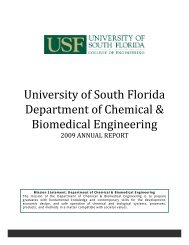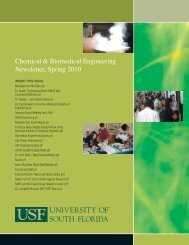2007 - Chemical & Biomedical Engineering - University of South ...
2007 - Chemical & Biomedical Engineering - University of South ...
2007 - Chemical & Biomedical Engineering - University of South ...
Create successful ePaper yourself
Turn your PDF publications into a flip-book with our unique Google optimized e-Paper software.
Dr. John Wiencek<br />
Pr<strong>of</strong>essor and Dean <strong>of</strong> <strong>Engineering</strong><br />
wiencek@eng.usf.edu<br />
(813) 974-3780<br />
website: http://www.eng.usf.edu/<br />
Education:<br />
Ph.D. <strong>Chemical</strong> <strong>Engineering</strong>, Case Western Reserve <strong>University</strong> 1989<br />
M.S. <strong>Chemical</strong> <strong>Engineering</strong>, Case Western Reserve <strong>University</strong> 1985<br />
B.S. <strong>Chemical</strong> <strong>Engineering</strong> <strong>University</strong> <strong>of</strong> Cincinnati 1984<br />
Research Interests: Protein Biophysics and Novel Membrane-based Water<br />
Purification. Integral Membrane Protein Crystallization<br />
CHARACTERIZATION OF pH-INDUCED<br />
AGGREGATION AND GELATION OF GLUCAGON<br />
Peptide hormones can form a wide variety <strong>of</strong> aggregate<br />
states in solution depending on pH and salt<br />
concentrations. For example, insulin and glucagon are<br />
known to both reversibly and irreversibly associate in<br />
solution. In the extreme, solution viscosity increases<br />
dramatically due to irreversible aggregation and<br />
eventually leads to the formation <strong>of</strong> a gelled phase. Such<br />
behavior can be catastrophic in the medicinal formulations<br />
or during the manufacture <strong>of</strong> these important drugs.<br />
Batch light scattering (both visible laser light as well as<br />
Xrays) and transmission electron microscopy studies on<br />
aggregating glucagon solutions provide some information<br />
on the initial and final states <strong>of</strong> this gelation process.<br />
Unlike prior work, this study attempted to provide<br />
geometrical measurements (molecular weights, size,<br />
shape) <strong>of</strong> the aggregated species during the gelation<br />
process. Some pathways for glucagon aggregation are<br />
suggested from this work. Speciation <strong>of</strong> the population <strong>of</strong><br />
aggregates in time by size exclusion chromatography was<br />
ineffective due to deep bed filtration <strong>of</strong> large aggregates<br />
with the concomitant increase in back pressure on the<br />
column or re-equilibration <strong>of</strong> the aggregated species to<br />
monomers (depending on eluent conditions). Our recent<br />
work on Flow Field Fractionation (FFF) suggests that<br />
isolation <strong>of</strong> highly aggregated peptide is possible via the<br />
combination <strong>of</strong> FFF and online light scattering methods.<br />
FFF has provided key supporting data for some <strong>of</strong> our<br />
early results and suggests the gelation process is<br />
catalyzed by pre-existent aggregates that are either in the<br />
glucagon lyophilized powder or formed upon dissolution.<br />
Recent Research Projects:<br />
‣ Physical Characterization <strong>of</strong> Technospheres<br />
and APIs Assessing Glucagon Gelation<br />
Mechanisms in the Production Environment<br />
‣ Static light scattering studies <strong>of</strong> OmpFporin:<br />
implications for integral membrane protein<br />
crystallization<br />
Recent Publications:<br />
S, Murugesan, J.M. Wiencek, R. Ren and R.J.<br />
Linhardt, “Benzoate-based room temperature ionic<br />
liquids—thermal properties and glycosaminoglycan<br />
dissolution” Carbohydrate Polymers, 63,<br />
268.(2006).<br />
L. Gakhar and J.M. Wiencek, “A possible additional<br />
role <strong>of</strong> mineral oil in successful flash cooling,” J <strong>of</strong><br />
Applied Crystallography, 38, 945. (2005).<br />
W.F. Jones, M.A. Arnold, and J.M. Wiencek,<br />
“Precipitant-controlled growth <strong>of</strong> lysozyme crystals in<br />
sodium thiocyanate” Crystal Growth & Design, 4,<br />
1387. (2004).<br />
L.T. Nguyen, J.M. Wiencek, and L.E. Kirsch,<br />
“Characterization methods for the physical stability<br />
<strong>of</strong> biopharmaceuticals,” PDA Journal <strong>of</strong><br />
Pharmaceutical Science and Technology, 57, 429.<br />
(2003).<br />
S.-Y. Hu, J. Li and J.M. Wiencek, “Feasibility <strong>of</strong><br />
Surfactant-Free Supported Emulsion Liquid<br />
Membrane Extraction,” J. <strong>of</strong> Colloid and Interface<br />
Science, 266, 430. (2003).<br />
20





